

CHAPTER XII.
REPETITION, ALTERATION, AND ALTERNATION
Importance and order of development of repetition as contrasted with congruity—
Repetition, a necessary and elementary factor in all forms—
Alteration—
How differing from variety—
Alternation and other allied methods—
The influence of repetition, alteration, and alternation upon thought—
How they are exemplified in nature—
In art; poetic repetition with alteration in lines, feet, alliteration, assonance, rhymes—
In recurring refrains, choruses: explanation of the French forms of verse—
In epithets and phrases—
Alternation in accent and lack of accent and in rhyming lines—
The three methods in music—
The three in primitive forms of ornamentation appealing to sight—
In painting: how imitated from nature and how produced by artistic arrangements of forms—
Even of landscapes—
The same in color—
In sculpture—
In architecture—
The fundamental reason why styles should not be mixed—
Necessity of unity of effect.
OF the three methods of bringing together forms that compare—by congruity, by repetition, and by consonance,—repetition has been assigned the second place, not because historically it was the second to be manifested in the development of art, nor because it is today the second in importance. On the contrary, reasons might be adduced, to show that it was the first to be developed and is today the first in importance. One might claim, in fact, that both congruity and consonance are modifications of it, and allowable merely as any variety is allowable. But while conceding all that could be proved in this direction, it seems to be true, nevertheless, that, in the composition of
[The Genesis of Art-Form by G.L. Raymond, chapter XII, page 188]
the higher arts, the artist starts with a form that embodies a general conception, a thought, and strives first to connect this with other forms embodying the same thought, or like it by way of congruity; and only later comes to repetition, which has to do with arranging such details as foot and rhyme, and line and limb, so that all the minutiae of form as form shall manifest the ever prevailing domination of comparison.
However, if thought can never become art until it be given a form, and if a form be, as has been said, an appearance; and if an artistic form be an appearance in which like is put with like, it is evident that the effect produced by the repetition or the same appearance is something which no artist, whatever the quality of his thought, can afford to neglect. Indeed, when we inquire into the causes of rhythm, proportion, and harmony of tone and color, as well as of all the subtler qualities that make the arts exactly what they are, we are forced to acknowledge that there is no one of them, as we now know them, the form of which is not based on repetition as an elementary method.
The contrasting form of repetition is alteration—a better term than change, because indicating a difference not so radical, and yet sufficient for that which is intended. It is comparatively easy to produce effects of variety by introducing forms that involve entire change, as in the different rhythms and movements in the quotations in Chapter II., page 20, and in the different sizes, positions, and attitudes given to the forms in Figs. 14, page 70, and 15, page 71, as well as to the different shapes given to the coverings of openings and to roofs and domes in Fig. 4, page 21; Fig. 5, page 33; Fig. 67, page 205, and to those of the “Design for a
[The Genesis of Art-Form by G.L. Raymond, chapter XII, page 189]
Theatre and Ton-Halle,” more than one half of which is presented in Fig. 6o, page 191, the other side being a counterpart of this. But it is not so easy to produce such effects by introducing alteration into forms that, throughout a composition, remain the same in principle; as in the different and yet similar metres in the quotations in Chapter II., on page 24; in the different and yet similar positions given to the forms in Fig. 16, page 73; Fig. 43, page 143; and Fig. 70, page 215; and in the different and yet similar shapes given to the coverings of openings and to roofs and domes in Figs. 2, page 17; 3, page I9; 12, page49; 31,page 88; 42, page 123; and Fig.68, page 207.
The latter course alone perfectly fulfils the requirement of art that variety should be kept subordinate to unity and comparison. At the same time, alteration thus interpreted evidently requires and manifests brain-work; and it is by the brain-work involved as much as by conformity to aesthetic laws, that the world in general measures artistic achievement. For instance in the “Public Library,” Fig. 61, page 193, can any one fail to recognize how much more thought it would have required to produce an equally effective entrance by having the same general shapes there as in the window caps at its side, yet altered; or to produce an equally successful side for the practical needs of a library, by having the same general shapes there as over the openings at the entrance? It is proper to say, therefore, that the Shadyside Presbyterian Church, by the same architects, fig. 34, page 91, is superior, artistically, to this Library, for one reason, because it manifests more brain-work.
Alteration and repetition used conjointly in such ways
[The Genesis of Art-Form by G.L. Raymond, chapter XII, page 190]
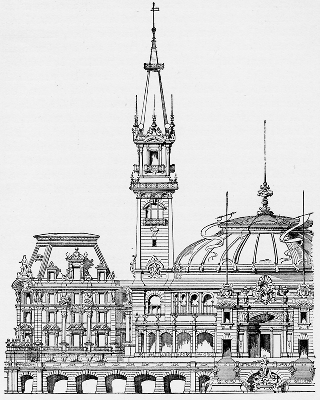 [click here to enlarge image]
[click here to enlarge image]
Fig. 60 – Part of Design for Theatre and Ton-Halle, Ruzich, Switzerland
(See pages 22, 190, 208, 261.)
[The Genesis of Art-Form by G.L. Raymond, chapter XII, page 191]
as to fulfil the principles underlying complement, counteraction, and balance1 lead to what we all know as alternation. The bringing together of related effects so that those that are alike in one regard are in one place, and those that are alike in another regard are in another place; as, for instance, when all the light in a painting is near the central-point, and all the shade at the sides, described about the light, is called massing or breadth. When like features are not massed but scattered and mixed, indiscriminately, with unlike ones, we have that development of confusion which may be termed interspersion.1 Repetition and massing, introduced notwithstanding apparent interspersion, give us an outgrowth of complement or balance called complication.1 Finally, when, under such conditions, order has had its perfect work, the outlining of the group that results manifests continuity.1
When we pass from congruity to the methods now to be considered, we leave the region where thought and effects upon thought are uppermost in the mind of the artist. Repetition and everything associated with it, have their origin in the exigencies of form. At the same time, we cannot be reminded too frequently that all forms, as used in art, are methods of representing thoughts or feelings by rendering them more concrete and emphatic. Recalling this, we have but to apply the principle to the methods before us, and we shall recognize that there are no ways of embodying thought in forms that are more certain than these to influence both sense and soul together. The slightest perceptible rubbing or scratching against any part of our body, if repeated a sufficient number of times, will cause inflammation. The slightest perceptible vibration that can affect the organs of hearing
1 Compare what is said here with the arrangement of methods on page 131.
[The Genesis of Art-Form by G.L. Raymond, chapter XII, page 192]
or sight, if repeated with sufficient rapidity and persistency, will produce a sound or a color, and nothing except repetition will do so. The same is true of its use when appealing more directly to the mind. “What a wonderfully complete system of police signalling these Germans have!” said an English gentleman to me in Stuttgart.
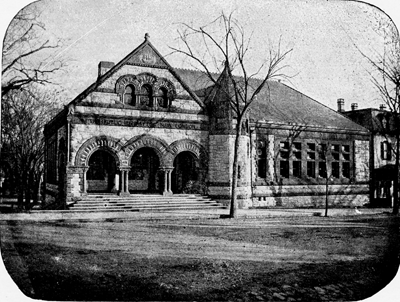 [click here to enlarge image]
[click here to enlarge image]
Fig. 61 – Public Library, New London, Connecticut.
(See pages 123, 190.)
“They are at it now, as they have been for nights past.” We stepped out upon a balcony which stood high on a hillside, and looked down upon the moon-lit city. “Listen,” he said; “first you hear a whistle off there at the railway station; then one at the palace; then one farther here on the hill.” I listened; and what I heard,
[The Genesis of Art-Form by G.L. Raymond, chapter XII, page 193]
and what he had heard, came from tree-toads in the garden under us. A single note would not have attracted his attention. It was the repetition of the notes that had filled his imagination with visions of socialists, and the efficiency of police supervision under a military government. So with objects in the field of sight. An ordinary fence made of continuous boards has little to cause us to notice it. Make it a picket fence, and the repetitions of the pales with the alternating spaces between them will at once give it interest. Introduce still more both of repetition and alternation, by placing here and there a post of a different pattern and capping, and the fence will become an important feature in the landscape, which no one can pass without observing.
As in the cases of the other methods that we have considered, repetition, alteration, and alternation are abundantly exemplified in nature: repetition with alteration, in the cry, chirp, hair, feathers, teeth, claws of every beast or bird; in the limbs, leaves, flowers, fruit of every tree or shrub; in the cliffs, stones, shells of every lake or river; and alternation s in the rise and fall of the sounds of the wind, of the notes of the bird, of the accented and unaccented syllables of speech; in the limbs of trees outlined against the intervening sky behind them ; in the veinings and plain surfaces of leaves; in the stripes of different colors upon shells or coats of animals; in the very fingers and the spaces between them on which the eyes must gaze when doing anything artistic. No wonder that art, in representing natural forms, should reproduce these effects, and, in elaborating its reproductions, develop them still further.
Let us notice now how this is done; and, first in poetry. What is it that causes form in this art? The most
[The Genesis of Art-Form by G.L. Raymond, chapter XII, page 194]
superficial thought reveals—what more thorough study confirms— that poetic form is made up almost entirely of a series of repetitions, of lines of like numbers of feet, of feet of like numbers of accented and unaccented syllables, and of alliterations, assonances, and rhymes of like sounds, all following one another in close succession. Yet few of these repeated elements are exactly the same. The rhymes and lines and feet and rhyming words in almost all poems that we admire, include sufficient alterations to relieve the repetitions of even a suggestion of sameness. Notice again the quotations in Chapter II., page 24.
The principle of repetition explains the use, too, of choruses and refrains with which we are all familiar. Notice the French forms of verse illustrating what is said on pages 55 and 107. Any one who will examine those selections, or the following, cannot fail to remark the amount of repetition in them, either in whole lines, phrases, or rhymes. Elaborate essays have been written in attempts to give the reasons that have led to the construction of these forms. It is one proof of the importance, if a man would understand a single art, of making a comparative study of all the arts, that, as this book shows, there are no reasons whatever underlying these French forms other than those underlying all art-forms. In fact, the roundel, rondeau, ballade, villanelle, triolet, and their like, are precisely what one ought to expect that a people, possessing so keen a sense of form as the French, would naturally and almost necessarily develop. Observe the repetitions in the following:
My day and night are in my lady's hand;
I have no other sunrise than her sight;
For me her favor glorifies the land;
Her anger darkens all the cheerful light,
[The Genesis of Art-Form by G.L. Raymond, chapter XII, page 195]
Her face is fairer than the hawthorne white,
When all a-flower is May the hedge-rows stand;
While she is kind, I know of no affright;
My day and night are in my Lady's hand.
All heaven in her glorious eyes is spanned;
Her smile is softer than the summer’s night,
Gladder than daybreak on the Faery strand;
I have no other sunrise than her sight.
Her silver speech is like the singing flight
Of runnels rippling o’er the jewelled sand;
Her kiss a dream of delicate delight;
For me her favor glories the land.
What if the Winter chase the summer bland;
The gold sun in her hair burns ever bright.
If she be sad, straightaway all joy is banned;
Her anger darkens all the cheerful light.
Come weal or woe, I am my lady’s knight,
And in her service every ill withstand;
Love is my lord in all the world’s despite,
And holdeth in the hollow of his hand
My day and night.
—Rondeau Redouble: John Payne
Where are the creatures of the deep,
That made the sea-world wondrous fair?
The dolphins that with royal sweep
Sped Venus of the golden hair
Through leagues of summer sea and air?
Are they all gone where past things be?
The merman in his weedy lair?
O sweet wild creatures of the sea!
O singing sirens, do ye weep
That now ye bear not anywhere
The swift oars of the seamen leap.
See their wild, eager eyes astare?
O syrens, that no more ensnare
The souls of men that once here free,
[The Genesis of Art-Form by G.L. Raymond, chapter XII, page 196]
Are ye not filled with cold despair—
O sweet wild creatures of the sea!
O Triton, on some coral steep,
In green-gloom depths, cost thou forbear
With wreathed horn to call thy sheep,
The wandering sea-waves to thy care?
O mermaids, once so debonnair,
Sport ye no more with mirthful glee?
The ways of lover-folk forswear?—
O sweet wild creatures of the sea!
Envoy
Deep down ‘mid coral waves, beware!
They wait a day that yet must be,
When ocean shall be earth’s sole heir—
O sweet wild creatures of the sea!
—Ballade of the Sea-Folk: William Sharp
A similar principle explains also the recurring epithets and phrases used in longer poems, in which the absence of rhyme and its allied elements renders the employment of the more common methods of repetition impracticable. There is a subtle effect of unity imparted by repetitions such as we find in Homer, of phrases like swift-footed, large-eyed, and winged words. The same is true of the repetitions of longer phrases and whole lines, as in the effects, also Homeric in origin, which are so admirably imitated by Tennyson in his “Passing of Arthur.”
Take Excalibur
And fling him far into the middle mere;
Watch what thou seest and lightly bring me word.
. . . . . . . .
Yet I thy hest will all perform at full,
Watch what I see and lightly bring thee word.
. . . . . . . .
As thou art lief and dear, and do the thing
I bade thee, watch and lightly bring me word.
[The Genesis of Art-Form by G.L. Raymond, chapter XII, page 197]
And again:
And caught him by the hilt and brandished him
Three times, and drew him under in the mere;
But ere he dipt the surface, rose an arm,
Clothed is white samite, mystic, wonderful,
And caught him by the hilt and brandished him
Three times, and drew him under in the mere;
And lightly went the other to the king.
Of which the knight Sir Bedivere tells as follows:
Then with both hands I flung him, wheeling him.
But when I looked again, behold an arm
Clothed in white samite, mystic, wonderful,
That caught him by the hilt and brandished him
Three times, and drew him under in the mere.
Alternation is almost equally characteristic of poetic form. Rhythm, with the feet and measures that enter as an essential factor into it, is dependent on the regularly alternating recurrence of accented and unaccented syllables. The effect of many of our rhyming verses, too, is dependent on the same method, the metre, length, and rhyme of one line corresponding to those of the second line following, and not to those of the first, e.g.:
The merry brown hares came leaping
Over the crest of the hill,
Where the clover and corn lay sleeping
Under the moon-light still.
—A Rough Rhyme on a Rough Matter: Kingsley.
Repetition, alteration, and alternation, are equally characteristic of the forms of music. In every shortest melody, like notes, phrases, refrains and cadences recur and alternate over and over again; yet always, in a composition that is successful, with sufficient alteration to prevent monotony. Notice illustrations of this in the music on
[The Genesis of Art-Form by G.L. Raymond, chapter XII, page 198]
<hr>
pages 25, 43 and 67, also in the following typical melody. Like strains in it are indicated by like capital letters, A, B, or C.
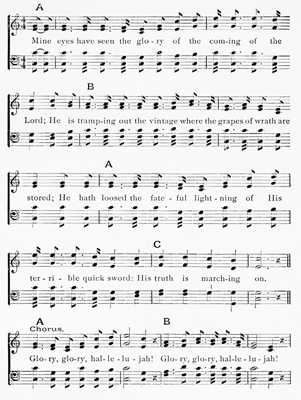
— Battle Hym of The Republic: Words by J.W. Howe.
[click here to enlarge image or click here to play music sample]
[The Genesis of Art-Form by G.L. Raymond, chapter XII, page 199]
The same methods are exemplified also in forms of art appealing to sight. The earliest kinds of ornamentation, as we can see it to-day in the rude lines scratched on ancient pottery, are merely series of repetitions; and in our own times the recurrence of similar outlines, however insignificant, when they are marked or worked near the edge of a piece of wood or cloth, gives it a border, and we admire it the more on account of the border. Or, if we ornament with more elaborate figures, it is mainly the repetition of them that causes them to be attractive. Take the Vitruvian scroll, as it is called, so frequently found in
 [click here to enlarge image]
[click here to enlarge image]
Fig. 62 – Vitruvian Scroll
pottery, goldsmith's work, and architecture, Fig. 62, or the Greek fret, Fig. 63.
 [click here to enlarge image]
[click here to enlarge image]
Fig. 63 – Greek Fret
The charm of these lies in the repetition. In connection with such ornamentation we often find alternation
[The Genesis of Art-Form by G.L. Raymond, chapter XII, page 200]
too. See this section of an ornamented doorway from Khorsbad, Chaldea, Fig. 64. In the older Greek temples, the Doric frieze was made up of a series of
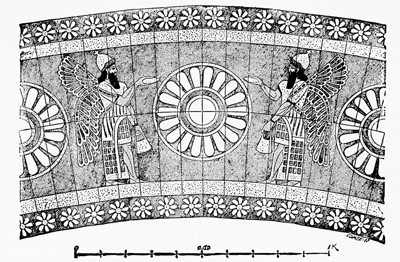 [click here to enlarge image]
[click here to enlarge image]
Fig. 64 – Section of ornamented doorway, from Khorsbad, Chaldea.
triglyphs alternating with metopes, either containing plane surfaces or else chaplets, or paterae, as in Fig. 65. So in the pavements, walls, and ceilings, both of ancient
 [click here to enlarge image]
[click here to enlarge image]
Fig. 65 – Triglyphs and Metopes.
and modern architecture, we often come upon repetitions and alternations of color, usually of white and red, or blue and red. The different ways, in fact, in which these
[The Genesis of Art-Form by G.L. Raymond, chapter XII, page 201]
methods of ornamentation may be used in decorative art, are almost infinite.
In order to apply the same methods to painting, it is not necessary for the artist to discover and imitate things actually repeated in the external world, any more than it is necessary for the poet to hear rhythmical language in order to arrange in rhythm his representations of what he hears. We might indeed, derive some pleasure from a picture; as we should from a view in nature, of a row of trees lining an avenue, or of a company of soldiers marching in procession. But a scene like this, unless it included other things, introducing variety into it, would seem artificial; inasmuch as it would be a copy—less of anything natural than—of something already put into artificial conditions by man. A more successful kind of repetition to be copied in a picture, would be like that found where images of trees and shrubs are reflected from the surfaces of rivers, showing the same things repeated indeed, but with some alteration and alternation. Or, instead of being mirrored, the trees might be repeated with effects equally satisfactory if, in their shapes, sizes, and positions, there were just sufficient alternation to give them the individuality that is found in nature. But the effects of repetition, for reasons already mentioned on page 150, are often secured merely by artistic composition; i.e., by arranging objects, not alike in every regard, in such ways that certain of their features are seen to be alike in some regards, or at least to suggest this likeness. The repetition thus introduced differs little, if at all, as will be noticed, from parallelism. But, as has been said before, all these art-methods are very closely connected, being all developed from similar principles.
It is easy enough to perceive how, in an ideal work, com-
[The Genesis of Art-Form by G.L. Raymond, chapter XII, page 202]
posed like Gerome’s “Pollice Versa,” repetitions could be introduced at will. But it is difficult to understand how the same can be done in painting a landscape, especially if copied from some definite scene. The problem, according to Ruskin (“Elements of Drawing,” Letter III.), was solved by Turner in a painting of the “Old Bridge on the Rhine at Coblentz,” in this way. Three boats and one raft were placed in the river, each holding two persons. Besides this, the distant single spires of the city were so
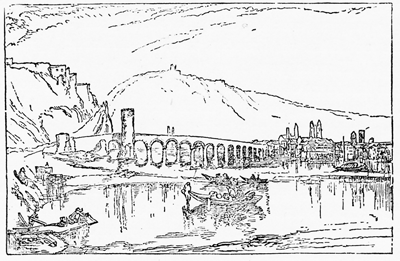 [click here to enlarge image]
[click here to enlarge image]
Fig. 66 – Old Bridge At Coblentz, by Turner.
(See pages 48, 159, 174, 203.)
grouped that, in three cases, two of these spires taken together (in each instance a large one and a small one, introducing thus, as will be noticed, the principle of alternation) looked like repetitions of each other and of two others on the bridge, the larger of which latter was the principal object in the foreground. Although there is really no one place from which the spires of the city can be seen in positions to produce these effects, Ruskin praises the painter for having the ingenuity to arrange his picture as if he had seen them thus. See Fig. 66.
[The Genesis of Art-Form by G.L. Raymond, chapter XII, page 203]
Color, too, may be applied so as to exemplify these methods. The effects of tone so much admired in a painting, effects produced where the whole of a scene presented seems to be dominated or pervaded by a similar hue, are largely due to constant repetitions, and, in some cases, under the influence of light and shade, of alterations and even alternations of the tints and shades.
In sculpture these methods are necessarily included in almost every faithful copy of that which is seen in nature; yet, in this art, too, there are opportunities for a purely original use of them, especially in the arrangements of folds of drapery and of different figures in groups. How impossible it would be to give attractiveness to the ideas embodied in the groups of the “Laocoon,” Fig. 75, page 226, and of “Niobe and her Children,” Fig. 45, page 146, were it not for innumerable repetitions in the expressions of the countenances and in the adjustments of limbs and drapery! “When we survey the ancient monuments of Egypt,” says Chas. Blanc in the introduction to his “Art in Ornament and Dress,” “abounding as they do in colored reliefs or surface paintings, we are often arrested by a group of figures in simultaneous and rhythmic action, all executing the same movement, the same gesture, and the same sign. When this action is not purely material, such as leading animals, thrashing out corn, or carrying bricks; when this action, I say, is in harmony with the sentiment; when it expresses, for example, worship or prayer, or the humility of a band of weeping captives prostrating themselves at the feet of the conqueror, their heads raised to him in supplication, this rhythmic movement partakes of a religious character, and the repetition of the gesture seems to bring it within the pale of sacred rites. The spectacle becomes solemn, nay, almost sublime,"
[The Genesis of Art-Form by G.L. Raymond, chapter XII, page 204]
Architecture, too, in all its most successful products, is full of illustrations of these methods. When applied to forms, they constitute the main element determining
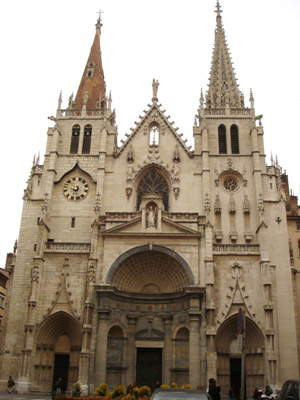 [click here to enlarge image]
[click here to enlarge image]
Fig. 67 – Church of St. Nizier, Lyons, France.
(See pages 22, 189, 206, 208, 261.)
photo credit: Jastrow (Wikipedia)
what is called a style of architecture; when applied to spaces, the main element determining what is called pro-
[The Genesis of Art-Form by G.L. Raymond, chapter XII, page 205]
portion. They manifest their presence, too, in a majority of the appearances of buildings with which we are most familiar; e.g., in rows of like columns with like flutings, in like mouldings stud carvings of entablatures, some of which have just been noticed; in walls strengthened by like buttresses and pierced at like intervals by windows of like shapes and sizes, as well as in cappings of openings and in pediments of gables and roofs, wherever any large numbers of these describe like angles.
The requirements of these methods, in fact, even more than those of congruity mentioned on page 146, underlie the principle that different styles should not be mixed; as they are, for instance, in this “Church of St. Nizier, Lyons,” Fig. 67, page 205. They base the principle, moreover, upon rational grounds, which is not done when it is said or implied that to observe it, is to do as the Greek or Gothic builders did. We are under no obligations to do as these did. The world may improve in art as in other things. Yet, as every thinker knows, all improvements are in the nature of developments that are made in strict accordance with fixed laws. We have found that scientific classification, as well as artistic construction, demands that like be put with like. This demand is beyond the reach of any human power that may seek to change it. It exists in the constitution of the mind. No architect can disregard it, and produce a building satisfactory to men in general. No building has ever obtained and preserved a reputation as a work of art, in which this requirement has been neglected. As a proof of this statement, as well as an evidence of the universality with which a principle can be applied when giving expression to a truth that is really fundamental, notice not only “Salisbury.” (Fig. 68, page 207), which is usually considered the most nearly perfect
[The Genesis of Art-Form by G.L. Raymond, chapter XII, page 206]
of the English cathedrals, but the classic buildings in all styles represented in Figs. 69, page 208; 1, page 15; 2, page 17; 3 page 19; 23, page 78; 31 page 88; 32, page 89; 42, page 123, and 97, page 292. The true reason, therefore, for not introducing the forms of Greek, Roman-
 [click here to enlarge image]
[click here to enlarge image]
Fig. 68 – Salisbury Cathedral, from the northwest.
(See pages 18, 76, 186, 190, 206, 261.)
photo credit: Andew Dunn (Wikipedia)
esque, and Gothic architecture into the same building, is that, as a rule, such a course is fatal to unity of effect. These principal styles and some of the subordinate styles developed front them differ so essentially that to blend them is to cause confusion in the form where the mind
[The Genesis of Art-Form by G.L. Raymond, chapter XII, page 207]
demands intelligibility, which, so far as our present line of thought is applicable, means something in which many repetitions of similar appearances reveal that all are parts of the same whole. Buildings in which there are very few, if any, forms alike, such as we find exemplified in
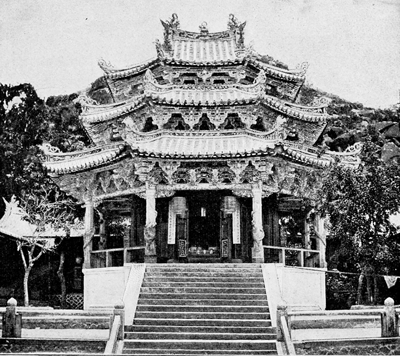 [click here to enlarge image]
[click here to enlarge image]
Fig. 69 – Poutou Temple, Ningpo, China.
(See pages 18, 124, 207, 264.)
Fig. 67 in this chapter, Figs. 4, page 21, and 5, page 23, and 6o, page 191, as well as in too many of those so popular in our own day, said to be erected in the style of Queen Anne, are not, whatever else they may be, works of art.
[The Genesis of Art-Form by G.L. Raymond, chapter XII, page 208]